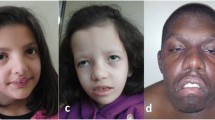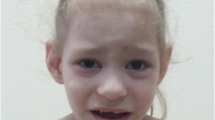Summary
The karyotype of a child with dysmorphic findings suggestive of both trisomy 13 and the 13q-syndrome was found to have cells with one of two different dicentric chromosomes: one bearing a duplication of chromosome 13q [46,XX,-13, + psu dic(13)t(13;13)(pter→ce→q34::q34→pter)] and the other a deletion of 13q [46,XX,-13,+psu dic(13)t(13;13)(pter→cen→q22::q11→pter). Longitudinal cytogenetic studies in leukocytes demonstrated a loss of those cells possessing the small dicentric [psu dic(13)(q22;q11)], whereas fibroblasts from two separate skin biopsies contained only this marker. Q-band polymorphisms indicated that both dicentrics were of paternal origin, with the smaller dicentric derived from the larger via the bridge-breakage-fusion cycle. The presence of two active centromeres could not be confirmed in either dicentric.
Similar content being viewed by others
References
Al-Nassar KE (1979) The distribution of genetic markers and Q-band heteromorphisms in the Kuwaiti population. Ph. D. Thesis, Indiana University
Bartsch-Sandhoff M, Schade H (1973) Zwei subterminale Heterochromatinregionen bei einer seltenen Form einer 21/21-Translokation. Hum Genet 18:329–336
Berg JM, Gardner HA, Gardner RJM, Goh EG, Markovic VD, Simpson NE, Worton RG (1980) Dic(21;21) in a Down's syndrome child with an unusual chromosome 9 variant in the mother. J Med Genet 17: 144–148
Cantu JM, Hernandez A, Plascencia L, Vaca G, Moller M, Rivera H (1980) Partial trisomy and monosomy 21 in an infant with an unusual de novo 21/21 translocation. Ann Genet (Paris) 23:183–186
de Grouchy J, Turleau C (1977) Clinical atlas of human chromosomes. John Wiley, New York
de la Chapelle A, Stenstrand K (1974) Dicentric human X chromosomes. Hereditas 76:259–268
Dewald GW, Boros SJ, Conroy MM, Dahl RJ, Spurbeck JL, Vitek HA (1979) A tdic (5;15)(p13;p11) chromosome showing variation for constriction in the centromeric regions in a patient with the cri du chat syndrome. Cytogenet Cell Genet 24:15–26
Disteche C, Hagemeijer A, Frederic J, Progneaux D (1972) An abnormal large human chromosome identified as an end-to-end fusion of two X's by combined results of the new banding techniques and microdensitometry. Clin Genet 3:388–395
Eiberg H (1974) New selective Giemsa technique for human chromosomes, Cd staining. Nature 248:55
Evans HJ, Ross A (1974) Spotted centromeres in human chromosomes. Nature 249:861–862
Ford CE (1967) Discussion of DNA replication patterns of chromosomes numbers 21–22 in female mosaic Mongols. In: Wolstenholme GEW Porter R (eds) Mongolism. CIBA Foundation Study Group No. 25. Little Brown and Company, Boston, p 71
Fraccaro M, LoCurto F, Vogel W (1978) Nuclear projections and latent centromeres in primary cultures and established cell lines. In: Barigozzi C (ed) Origin and natural history of cell lines. Prog Clin Biol Res 26:181–202
Gorlin RJ (1977) Classical chromosome disorders. In: Yunis JJ (ed) New chromosomal syndromes. Academic Press, New York, pp 60–117
Goto K, Meada S, Kano Y, Sugiyama T (1978) Factors involved in differential Giemsa-staining of sister chromatids. Chromosoma 66: 351–389
Hagemeijer A, Smit EME (1977) Partial trisomy 21. Further evidence that trisomy of band 21q22 is essential for Down's phenotype. Hum Genet 38:15–23
Hair JB (1953) The origin of new chromosomes in Agropyron. Hereditas 6:215–233
Hassold T, Wisniewski L, Higgins JV (1977) A syndrome of mental retardation associated with extra dicentric chromosomes. Am J Hum Genet 29:A53
Hodes ME, Cole J, Palmer CG, Reed T (1978) Clinical experience with trisomies 18 and 13. J Med Genet 15:48–60
Howell WM, Black DA (1980) Controlled silver-staining of nucleolus organizer regions with a protective colloidal developer: A 1-step method. Experientia 36:1014–1015
Hsu TC, Pathak S, Cailleau R, Cowles SR (1974) Nature of nuclear projections in an adenocarcinoma of the breast. Lancet II:847
Jernigan D, Curl N, Keeler C (1974) Milledgeville mongoloid: A rare karyotype of Down's syndrome. J Hered 65:254–257
Karukaya S, Ono E, Yokoyama H, Yanagisawa S, Takagishi S (1978) Two cases of dicentric chromosomes. Jinrui Idengaku Zasshi 23:297
Laurent C, Biemont M-C, Philip T, Dutruge J, Bellon G, Bethenod M, Gilly R, Ladreyt JF (1978) Translocation termino-terminales de novo entre deux chromosomes 18. A propos de deux observations 46,XY, ter rea (18;18)(pter;pter). Ann Genet (Paris) 21:78–82
Madan K, Vlasveld L, Barth PG (1981) Ring-18 and isopseudodicentric-18 in the same child: A hypothesis to account for common origin. Ann Genet (Paris) 24:12–16
Maraschio P, Zuffardi O, LoCurto F (1980) Cd bands and centromeric function in dicentric chromosomes. Hum Genet 54:265–267
Nichols WW, Miller RC, Hoffman E, Albert D, Weichselbaum RR, Nove J, Little JB (1979) Interstitial deletion of chromosome 13 and associated congenital anomalies. Hum Genet 52:169–173
Oka S, Nakagome Y, Teramura F, Hosono F, Katumata M (1977) Trisomy/partial monosomy mosaicism of No. 13 pair [46,XX,-13 rob(13q13q)/46,XX r(13)(p11q34). Jinrui Idengaku Zasshi 22: 73–78
Schreck RR, Breg WR, Erlanger BF, Miller OJ (1977) Preferential derivation of abnormal human G-group-like chromosomes from chromosome 15. Hum Genet 36:1–12
Sears ER, Camara A (1952) A transmissible dicentric chromosome. Genetics 37:125–135
Skovby F, Niebuhr E (1976) Centromeric inactivation in dicentric human chromosomes. Excerpta Medica International Congress Series No. 397. Elsevier/North Holland Inc, New York, NY, USA, pp 153–154
Stack SM (1974) Differential Giemsa staining of kinetochores and nucleolus organizer heterochromatin in mitotic chromosomes of higher plants. Chromosoma 47:361–378
Stengel-Rutkowski S, Zankl H, Rodewald A, Scharrer S, Chauduri JP, Zang KD (1976) Aspermia, associated with a presumably balanced X/autosome translocation. Hum Genet 31:97–106
Subrt I, Blehova B, Taborsky O (1971) Dicentric chromosome due to an unusual fusion. Hum Genet 12:136–141
Sumner AT (1972) A simple technique for demonstrating centromeric heterochromatin. Exp Cell Res 75:304–306
Therman E, Sarto GE, Patau K (1974) Apparently idodicentric but functionally monocentric X chromosome in man. Am J Hum Genet 26:83–92
Turleau C, Roubin M, Chavin-Colin F, de Grouchy J (1980) Trisomie 21 par duplication en miroir 46,XX, psu dic (21) ter rea (21q21q). Ann Genet (Paris) 23:187–189
Van Dyke DL, Weiss L, Logan M, Pai GS (1977) The origin and behavior of two isodicentric bisatellited chromosomes. Am J Hum Genet 29:294–300
Wang LY, Palmer CG (1974) A routine trypsin procedure for use in banding chromosomes and autoradiographs. Mammal Chrom Newsl 15:26
Ward BE, Bradley CM, Cooper JB, Robinson A (1981) Homodicentric chromosomes: A distinctive type of dicentric chromosome. J Med Genet 18:54–58
Wyandt HE, Wysham DG, Minden SK, Anderson RS, Hecht F (1976) Mechanisms of Giemsa banding of chromosomes. I. Giemsa-11 banding with azure and eosin. Exp Cell Res 102:85–94
Zuffardi O, Danesino C, Poloni L, Pavesi F, Bianchi C, Gargantini L (1980) Ring chromosome 12 and latent centromeres. Cytogenet Cell Genet 28:151–157
Author information
Authors and Affiliations
Rights and permissions
About this article
Cite this article
Schwartz, S., Palmer, C.G., Weaver, D.D. et al. Dicentric chromosome 13 and centromere inactivation. Hum Genet 63, 332–337 (1983). https://doi.org/10.1007/BF00274757
Received:
Revised:
Issue Date:
DOI: https://doi.org/10.1007/BF00274757




